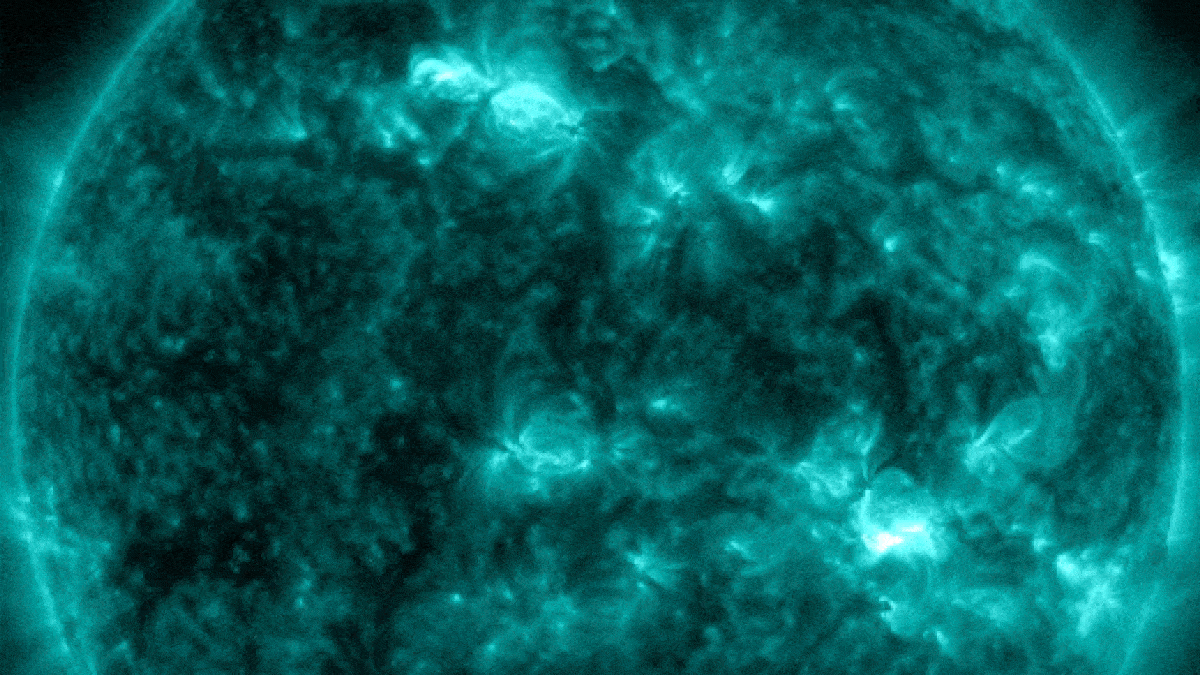Near-simultaneous solar flares explode from opposite sides of the sun in extremely rare event
A pair of linked solar flares recently exploded near-simultaneously from sunspots on different hemispheres of our home star, triggering radio blackouts on Earth.

A pair of powerful solar flares recently exploded "almost simultaneously" from two different sunspots located on opposite hemispheres of our star. The extremely rare phenomenon, known as a sympathetic solar flare, is another reminder that we are fast approaching the explosive peak in the sun's 11-year cycle, known as the solar maximum.
On Jan. 22, at around 10:30 p.m. ET, the two solar flares exploded at almost the exact same time from sunspots AR3559 and AR3561, which, at the time, were separated by around 310,000 miles (500,000 kilometers) — farther than the average distance between the moon and Earth, according to Spaceweather.com.
The flares had a combined power equivalent to a M5.1 magnitude flare, the second most powerful class of flare the sun can produce. The erupting twin flares also launched a wave of high-energy particles toward Earth that triggered a 30-minute radio blackout above Indonesia and parts of Australia when it slammed into our planet's magnetic field, according to Spaceweather.com.
Solar flares can also launch fast-moving clouds of magnetized plasma into space, known as coronal mass ejections (CMEs), which can barrel into Earth and trigger geomagnetic storms that create colorful auroras. But on this occasion, neither flare seems to have released a CME.
Related: 10 solar storms that blew us away in 2023
Solar flares can occasionally occur in rapid succession from the same sunspot; this can trigger "cannibal CMEs" if the flares both launch solar eruptions that later merge into a larger solar storm. But a sympathetic solar flare is a completely different beast.
In the past, researchers assumed that a sympathetic flare was just a freak coincidence. But a 2002 study revealed that the flare pairs are actually linked together — or more accurately, their sunspots are linked together by massive, invisible magnetic field loops that arc around the sun. Therefore, the flares can be considered as two parts of a single explosion.
Sign up for the Live Science daily newsletter now
Get the world’s most fascinating discoveries delivered straight to your inbox.
The twin components of a sympathetic flare can be separated by up to 30 minutes, according to the study. It is unclear exactly how much time elapsed between the eruptions from the recent pair, but they were likely separated by only a few minutes if not mere seconds, according to footage captured by NASA's Solar Dynamics Observatory.
Sympathetic flares are extremely rare but they can become more common during solar maximum, when the sun's magnetic field starts to break down and becomes more entangled with itself, a 2022 study analyzing 40 years of solar flare data revealed.
Solar activity has been quickly ramping up over the last 12 months. During this time, we have seen an increase in the number and size of sunspots, as well as more frequent and more powerful solar flares.
Most recently, the sun unleashed a CME on Jan. 20, which was predicted to trigger a geomagnetic storm that brings auroras to parts of the U.S. on Jan. 23.
Scientists originally predicted that the solar maximum would arrive in 2025 and be weak compared to past maximums. But mounting evidence to the contrary has changed their minds — they now believe that the sun's chaotic peak could begin in the next few months, if it hasn't already.

Harry is a U.K.-based senior staff writer at Live Science. He studied marine biology at the University of Exeter before training to become a journalist. He covers a wide range of topics including space exploration, planetary science, space weather, climate change, animal behavior and paleontology. His recent work on the solar maximum won "best space submission" at the 2024 Aerospace Media Awards and was shortlisted in the "top scoop" category at the NCTJ Awards for Excellence in 2023. He also writes Live Science's weekly Earth from space series.










